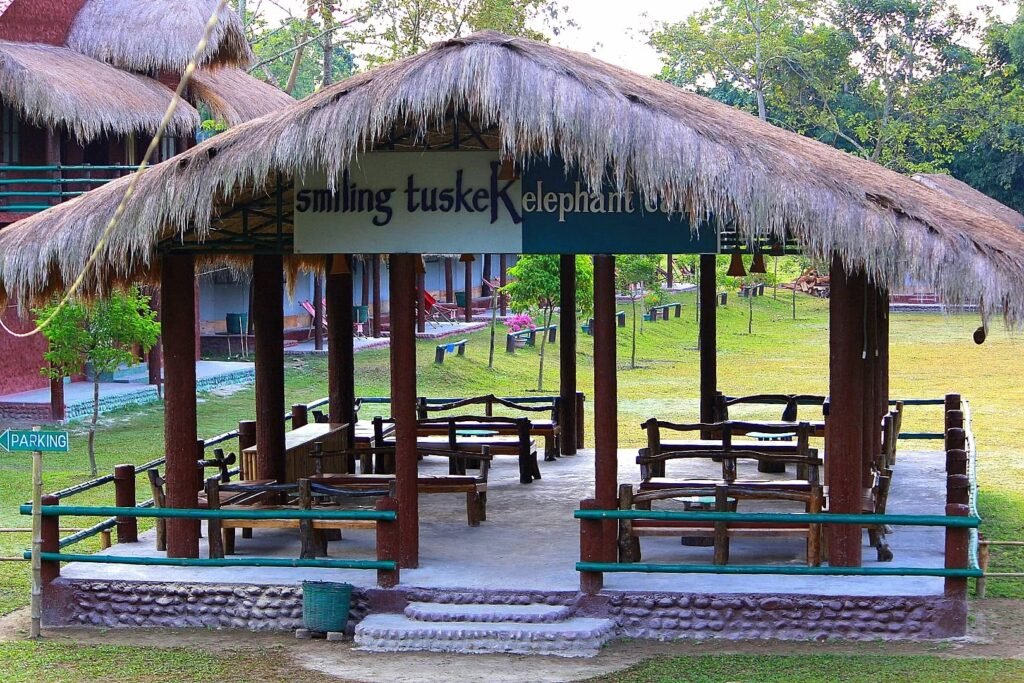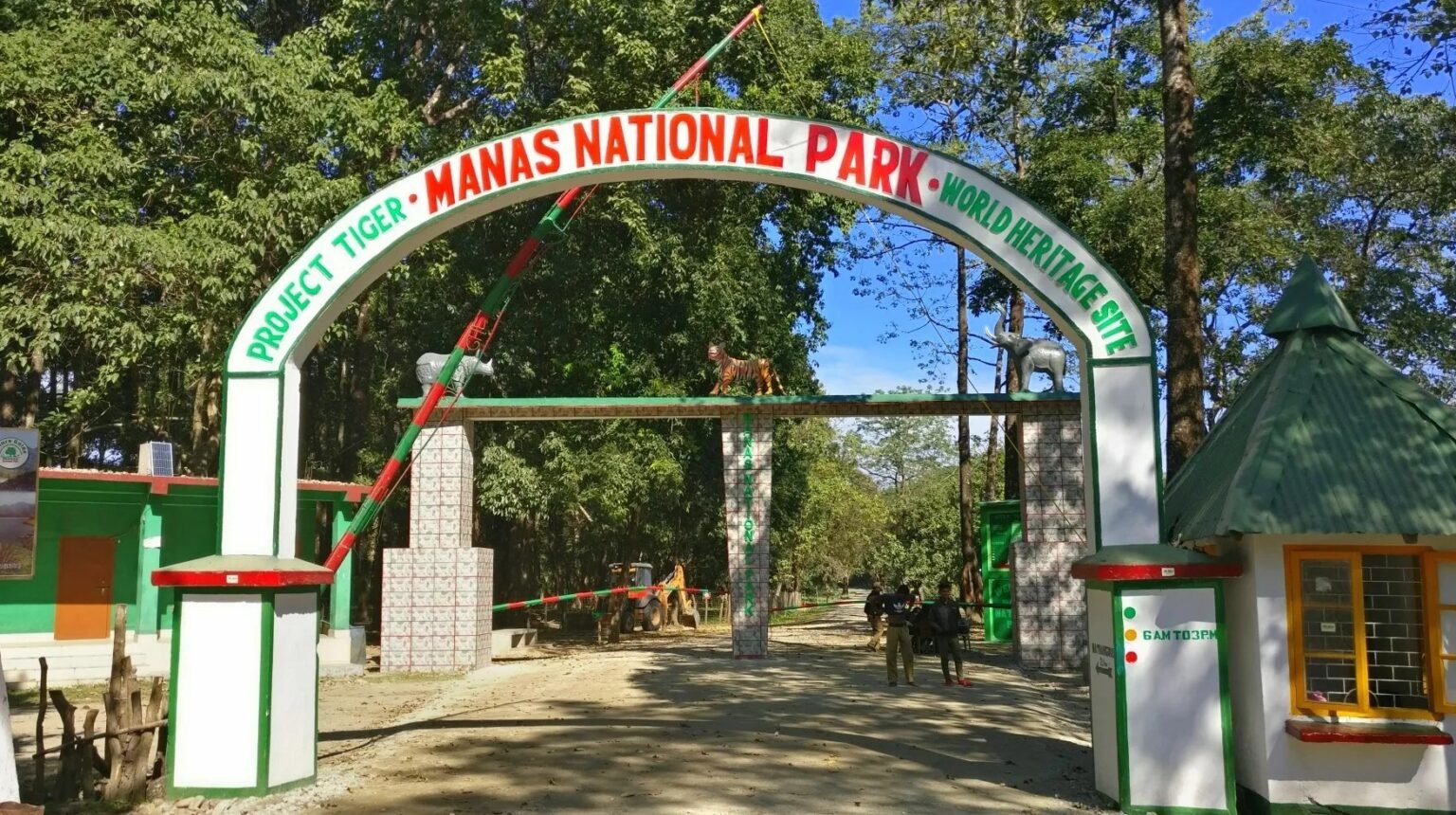Manas National Park, situated in the Himalayan foothills of Assam, is one of India’s most celebrated nature reserves and a UNESCO World Heritage Site, offering visitors a rich blend of biodiversity, tribal culture, and adventure in the heart of Northeast India.
Key Details:
| Aspect | Details |
|---|---|
| Location | Bengal tiger, Indian rhinoceros, pygmy hog, clouded leopard, wild buffalo, golden langur, and elephants |
| Area | 500–2,837 sq km (core park: 500 sq km; buffer extends larger) |
| UNESCO Status | World Heritage Site, Biosphere Reserve, Project Tiger & Elephant Reserve |
| Notable Wildlife | Forest lodges, resorts at Mathanguri; resorts outside the park |
| Bird Species | Over 450 (e.g., Bengal florican, great hornbill, black-necked stork) |
| Flora | 89 tree species, 15 orchid species, lush grasslands, rivers |
| Cultural Significance | Named after the Manas River, the indigenous communities inside the park |
| Activities | Jeep safari, elephant safari, bird watching, river rafting, village tours |
| Ideal Visiting Time | November to April (best: December–February); avoid June–September (monsoon) |
| Safari Timings | Jeep: 6:30–9:30 am, 10:00 am–1:00 pm, 2:00–5:00 pm; Elephant: 6:00–8:00 am |
| Safari Price (Indian) | Jeep: ₹4,500–5,900 (for 5); Elephant: ₹1,400 per person (1 hour) |
| Safari Price (Foreign) | Jeep: ₹8,500–9,000 (for 5); Elephant: ₹3,200 per person (1 hour) |
| Accommodation | Forest lodges, resorts at Mathanguri; resorts outside park |
| How to Reach | 160–176 km from Guwahati by road (NH-31); nearest rail: Barpeta Road; nearest air: Guwahati Airport |
| Entry Permission | Obtainable at the Field Director’s office, Barpeta Road; tickets online/at the gate |
Historical Significance
The history of Manas dates back to the days of royal hunting reserves owned by the Cooch Behar family and the Raja of Gauripur, prior to British colonial rule. It was officially declared a sanctuary in 1928, and later expanded in area and protection status:
- 1928: Manas was declared a wildlife sanctuary.
- 1973: Included in Project Tiger, becoming a Tiger Reserve.
- 1985: Inscribed as a UNESCO World Heritage Site.
- 1988: Gained importance under UNESCO’s World Heritage Convention.
- 1989: Declared a Biosphere Reserve.
- 2008: Expanded to cover 500 sq. km.
- 2011: Removed from UNESCO’s endangered list after active conservation efforts restored its wildlife and security.
The resilient park survived years of poaching and insurgency, emerging as a triumph of ecological restoration and community engagement.
Culture and Indigenous Communities
Manas National Park is home to several indigenous tribal communities, each with unique customs and traditions. The principal inhabitants are the Bodo people, Assam’s largest tribal group, renowned for their music, vibrant attire, and festivals such as Bwisagu (Bodo New Year) and Domashi (Harvest Festival). Other important communities include the Rabha tribe, known for its matriarchal practices and traditional beer brewing, as well as a variety of ethnic groups whose livelihoods depend on agriculture, weaving, and forest resources.
A visit to Manas offers guests a chance to engage with village life, traditional dances, and festivities, enriching the wildlife experience with authentic cultural immersion.
Biodiversity and Conservation
Manas National Park is famous for its extraordinary wildlife diversity:
- Endangered Animals: Bengal tiger, Indian rhinoceros, clouded leopard, pygmy hog, golden langur, wild water buffalo, Assam roofed turtle, and hispid hare.
- Birds: Over 450 bird species, including the Bengal florican, great hornbill, and black-necked stork, make it a paradise for birdwatchers.
- Mammals, Reptiles, Amphibians: 60 mammal species, 42 reptiles, and 7 amphibians.
- Flora: Lush cover of grasslands, semi-evergreen forests, 89 tree species, 15 orchids, and 43 grasses that create rich forage and habitats.
Manas shelters the world’s only viable population of the pygmy hog and supports rare endemic wildlife, making it a global conservation hotspot. Recognised as a Biosphere Reserve, the park is committed to sustainable practices and safeguarding ecological balance.
Tourism and Attractions
Manas National Park offers an array of activities and attractions catering to adventure seekers, wildlife enthusiasts, and culture lovers:
- Jeep and Elephant Safaris: Encounter the majestic tigers, elephants, rhinos, and buffalo. Jeep safaris run daily, while elephant safaris provide access to remote areas that are not accessible by vehicle.
- Birdwatching: Guided tours to spot rare and migratory birds.
- Eco-Tourism: Cultural tours to Bodo villages, nature walks, and visits to tea plantations.
- River Rafting: Adventurous rafting on the Manas River, allowing views of wildlife along its banks.
- Picnic Sites and Lodges: Picturesque picnic spots and eco-lodges, especially at Mathanguri, provide serene retreats for families and groups.
Popular tourist spots within and around the park include the Bansbari Tea Plantation, the ancient Banasur Ka Gohain stone structure, the Palace of the King of Bhutan, and vibrant local festivals such as the Dwijing Festival.
Location and How to Reach
Manas National Park is located in the Barpeta and Chirang districts of Assam, bordering Bhutan. The nearest major city is Guwahati, about 133-176 km away. Travellers can reach Manas by air, rail, or road:
- By Air: Lokpriya Gopinath Bordoloi International Airport (Guwahati) is the nearest, approximately 138 km away.
- By Train: Barpeta Road Railway Station (20 km from the park) is well-connected to major cities.
- By Road: National Highway 27 connects Guwahati and Barpeta Road, and regular buses/taxis ply between Guwahati and the park entrance.
The park spans an area of approximately 950 square kilometres, with the Manas River flowing through its heart, creating a profound scenic landscape of jungles, wetlands, and grasslands.
Travel Tips
Photography: Carry binoculars and cameras to capture the park’s stunning flora and fauna.
Permits: Secure permits and book safaris in advance, especially during peak season.
Dress Appropriately: Wear neutral colours and comfortable shoes for safaris and walks.
Respect Wildlife: Maintain silence and follow guides’ instructions in the park.
Experience Local Culture: Participate in community visits to enrich the travel experience.

Recent Tourism Revenue and Economic Impact
Manas National Park saw record tourism growth in 2024-25, earning ₹1.58 crore in just eight months and welcoming over 64,000 tourists (60,744 domestic and 3,719 international). Earlier months saw a collection of ₹33 lakh and 10,000+ visitors, demonstrating the rising interest in wildlife and cultural tourism.
This revenue supports conservation, local communities, eco-tourism initiatives, and capacity building for sustainable tourism. Increased wildlife sightings, improved infrastructure, and vibrant eco-tourism practices have contributed to its global appeal.
Latest News: 2025 Tourist Season
The 2025-26 season opened with great fanfare. Official ceremonies at the Bansbari Range welcomed tourists to the Manas National Park’s three main ranges: Bunsbari, Buyara, and Panvari. Safaris, river rafting, and cultural immersion are in full swing with increased visibility of tigers, elephants, and migratory birds. Park management and local communities united in a celebratory march, emphasising the spirit of collaboration and the vibrancy of Manas’s ecological and cultural landscape.
FAQs About Manas National Park
What is the best time to visit Manas National Park?
November to April is ideal, with pleasant weather and high chances of wildlife sightings.
Which wildlife can be spotted in Manas National Park?
Bengal tiger, Indian rhinoceros, wild water buffalo, pygmy hog, golden langur, clouded leopard, Assam roofed turtle, and hundreds of bird species.
How do I book safaris and lodging inside the park?
Safari bookings and lodge reservations can be made online through the park’s website or authorised tour operators; Mathanguri forest lodges are popular.
Are guided cultural tours available?
Yes, visitors can opt for guided village tours that offer insights into Bodo traditions, local festivals, and handicrafts.
What are the main entry gates and tourist ranges in Manas?
Bansbari, Bhuyanpara, Panbari, and Kuklung are the main ranges, each with distinct wildlife experiences and access points.
Is river rafting safe for children and senior visitors?
Managed by certified guides, river rafting on the Manas River is generally safe; however, families should consult with the authorities at Manas National Park regarding age and health advisories.
Can foreign tourists visit Manas National Park?
Absolutely, international tourists are welcomed and form a significant segment of visitors each year.
How does tourism revenue help conservation?
Tourism revenue supports habitat protection, anti-poaching efforts, eco-development projects, and upliftment of indigenous communities.
Are there restrictions or permits required for entry?
Yes, visitors must obtain official entry permits from the park office or online in advance; these regulations ensure visitor safety and wildlife preservation.
